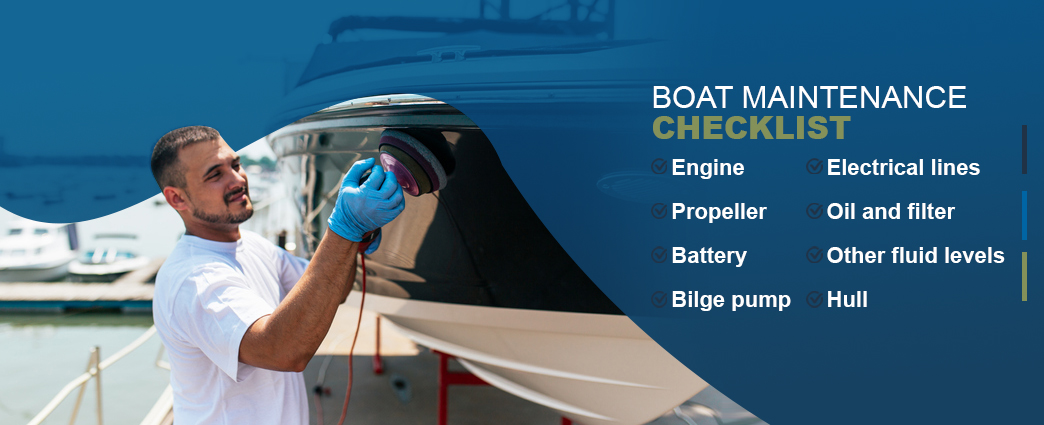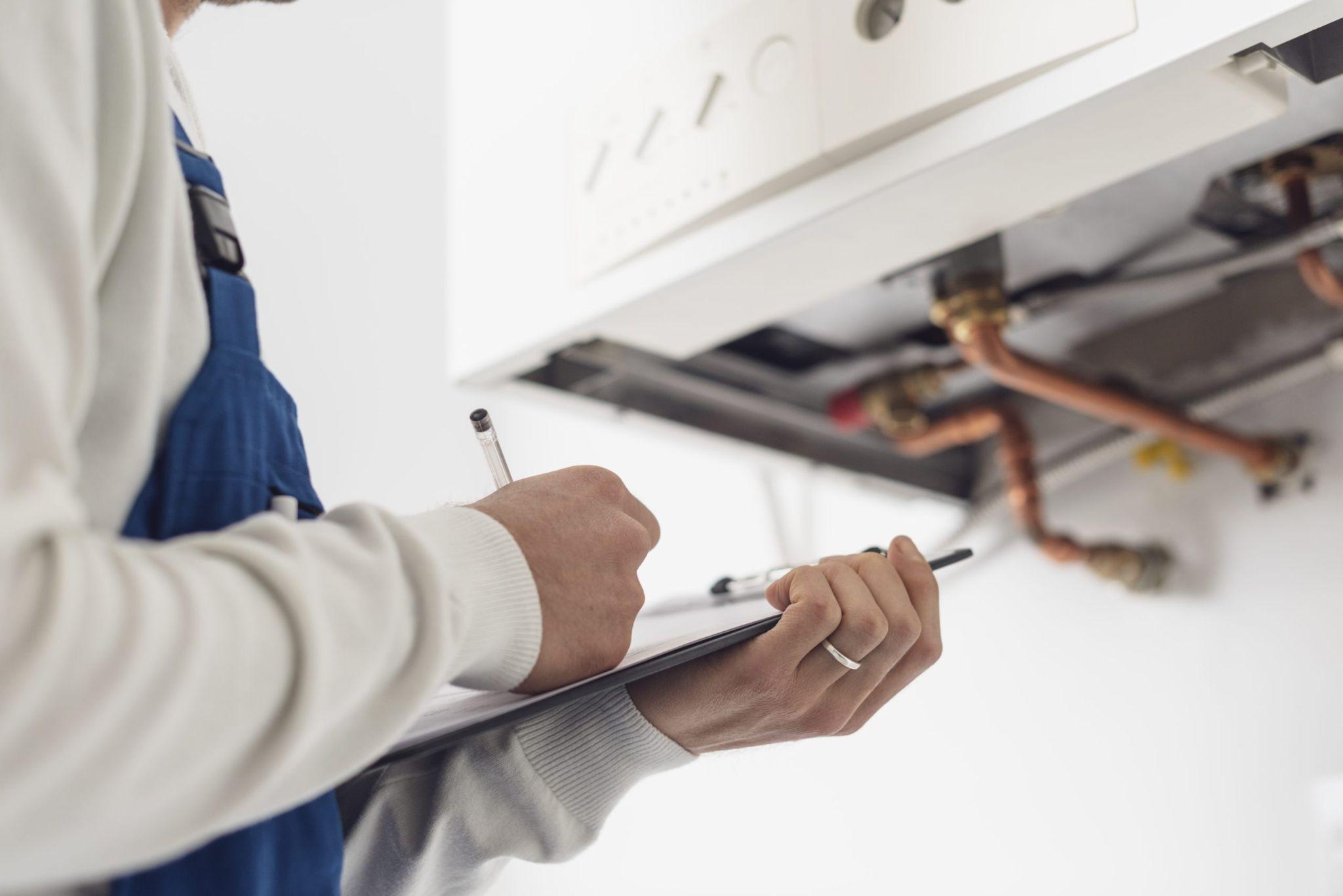Learning
The One and Only Boat Maintenance Guide That You’ll Ever Need

Boat maintenance: Like RVs, boating industry sales reached record highs during 2020, and the trend looks to continue for the foreseeable future. Outings on a boat are an excellent way to enjoy the excitement of the great outdoors from another angle.
Driving a boat is a relatively easy skill to master, and you can use your vessel for a wide range of activities. Whether you intend to go fishing, water-skiing, or sunset cruising, all boats have one thing in common.
Boat maintenance is essential for your enjoyment. Keep reading to find out more about this essential part of boat ownership and what it is like to have a boat on a site like boatsforsale.co.uk.

Why Is Boat Maintenance Important?
Unless you’re a member of a fractional boat ownership club, you’re responsible for ensuring your boat remains in good running order all year round. A poorly maintained boat can become unseaworthy and dangerous for passengers and crew.
When you care for your boat properly, you can also expect it to stay in immaculate condition for longer.
Whether you’re boating on rivers, oceans, or lakes, it’s vital to conduct a visual inspection of your boat before and after you hit the water.
This cursory inspection can reveal potential maintenance issues or damages incurred during your last outing.
The best boat care practices include a regular maintenance schedule, ongoing upkeep, and occasional mechanical adjustments.
What Do You Need to Maintain Your Boat?
You should have no problem completing most aspects of boat maintenance without the help of a mechanic. To do this, you’ll need a few supplies and tools.
These are:
- Basic tools like an adjustable wrench, screwdriver, and pliers
- A long-handled brush or spray wand for washing your boat
- Specialized soap for boat cleaning
- Anti-corrosive fluid
- A digital multimeter
- A small wire brush to clean your boat
If you need to complete more specialized tasks, you can buy the equipment you need when you need it.

Cleaning Your Boat
Cleaning your boat every time you use it will keep it looking great for years to come, but it also helps prevent the spread of invasive species between water bodies.
You never know which tiny organism is hitching a ride on your boat.
If you take your boat out on the ocean, cleaning it after use will help keep the finish intact. Sea salt can erode your boat’s finish, causing unsightly and permanent abrasions.
It’s best to clean your boat away from water sources to prevent any soap or chemicals from polluting the water. It’s best to use environmentally-friendly, non-toxic products and make sure you hose your boat down thoroughly after cleaning it.
You should always use the correct cleaning materials depending on the material you’re cleaning, as follows:
Fiberglass
Fiberglass boats usually have a gel coat finish to protect the surface from the weather and salt.
If you don’t look after this coating, it will soon take on a cloudy appearance.
To prevent this, it’s important to rinse your boat after every outing and wax or polish it at least twice a season using products approved for use on fiberglass.
Scrubbing gently with a soft brush or cloth removes surface grime.
Canvas
Most boat covers, cockpits, and some other parts of your boat might comprise canvas.
Taking good care of this material helps ensure it maintains its waterproof properties.
Clean canvas using mild soap, clean water, and a soft brush.
Be sure to avoid cleaning any PVC windows in the canvas with ammonia. It will damage this material over time.
Always clean PVC with an approved cleaner.
Woodwork
If your boat features any wooden portions, like decks or handrails, they’re likely made of durable teak.
You should clean them occasionally using a mild cleaner and working across the grain with a soft bristle brush.
Upholstery
Most boat seats have durable vinyl covers, which are easy to clean. If you don’t clean vinyl regularly, dirt build-up can lead to mould and mildew formation.
Wipe your seats down regularly using a soapy sponge, and then wipe them down with a clean cloth to remove any soap residue.
Finally, you should dry your seats afterward and keep them covered or stored away when they’re not in use.

A Comprehensive Boat Maintenance Checklist
A checklist helps ensure you don’t miss out on any key aspects of maintaining your boat.
These are the things you should diarize to ensure your vessel stays in top condition:
Before You Launch Your Boat
For safety’s sake, you must check a few things before you head out on the water. These are:
Oil and Oil Filter
You should change your oil and oil filter regularly to prevent damage to your boat’s engine. When you need to change the oil, simply let the engine run for seven minutes, then turn it off.
Place a container under the drain plug, remove the plug, and loosen the screw above it. The oil should take around 30 minutes to drain.
Once done, change your oil filter, replace the drain plug, tighten the screw, and fill the engine with the correct oil. Make sure your oil levels are optimum before you use your boat.
Propeller
A faulty propeller affects your boat’s performance and fuel consumption. Always check the propeller on your stern drive or outboard motor before you launch.
Make sure the propeller nut is secure, and tighten it with a deep socket wrench when needed. You should also inspect the propeller for small dents.
Twice a year, remove the propeller to make sure nothing’s wrapped around it, and grease the shaft at the same time.
Steering
Check the movement of the steering wheel. A glitch in this area may cause a serious accident. Occasionally, you should check the steering fluid levels and top up if necessary.
The Hull
Be sure to wash the boat’s hull and deck before use and check the hull for damages. Make sure all the drain plugs are in place.
Bilge Pump
Excess water collects in the bilge, the bottom part of the boat. The bilge pump removes this water to stop your boat from sinking.
Test your bilge pump by placing some water in it and turning the pump on. If it doesn’t remove the water as it should, check the bilge pump hoses for clogs.
If it’s still not working after clearing the hoses, you must get it repaired before you use your boat. It’s a good idea to buy a backup bilge pump, so you can enjoy your boat uninterrupted if this happens.
Battery and Electric Systems
Your boat’s battery works like a heart, it powers the electrical system, and your boat can’t function without it. If your boat doesn’t start, check the 24v lifepo4 battery.
You can check its charge with a multimeter, and you should regularly inspect the connections for corrosion.
Check that your electrical lines are in good shape, as deteriorating lines can cause an electrical fire on board. Keeping your electrical lines clean is the first step toward preventing them from degrading.
Safety Equipment
Never drive off in your boat without checking all the safety equipment.
Make sure your life preservers are in good order, check the lights and safety horn, and ensure the batteries in your carbon monoxide and smoke alarms are still good.
Check your fire extinguisher and flare expiration dates and replace them if necessary.
You should always store these items in dry areas where you can reach them quickly if needed.
20-Hour Checklist
When you’ve run your boat for twenty hours you must treat the fuel with a decarbonizer, check the engine’s RPM, refill the engine oil and check the lower unit for water.
This is also a good time to clean your boat inside and apply any protective measures to the upholstery.
50-Hour Inspection
Your to-do list after fifty hours of operation includes checking the fuel lines for damage, inspecting the steering system for leaks, and topping up steering fluid if necessary.
You should wax and polish your boat’s deck and hull, and clean the bilge pump at this stage too.
100-Hour Maintenance Aspects
After 100 hours on the water, it’s a good idea to get a qualified mechanic to check your boat’s engine. Other tasks include:
- Lubricating the grease points
- Refilling the power trim and tilt fluid
- Touching up the damaged paint
- Tightening all accessible fasteners and bolts
- Replacing the water pump impeller, fuel filters, and oil filters
- Checking the bow and stern eyes for wear
- Inspecting the rub rail for damage

Maximize Your Leisure Time
Owning a boat opens up many avenues of recreation and exploration, and taking good care of your boat can help minimize the expenses related to owning one of these luxury recreational vehicles.
These few boat maintenance pointers will ensure your boat stays in good shape and gives you many years of safe and enjoyable service.
Would you like some more tips on how to get the most out of life?
Bookmark our site, and check back regularly for more information on how to make the most of your free time.
Related CTN News:
Camp Finest Unveils Screen Tents Ahead Of the 2022 Summer
Quick Tips to Help You Find the Best Dhow Cruise Dubai Company
Top 5 Countries for IT Outsourcing in Eastern Europe: 2022 Market Research

Learning
First-Time Buyer’s Guide to the UK Property Market

Entering the UK property market as a first-time buyer can feel both exciting and daunting. The process is filled with potential pitfalls and complex decisions, but with the right guidance, it can be navigated smoothly. The estate agents in Yorkshire demystify the journey from the initial decision to buy a home to the moment you step over the threshold of your new property.
Understanding Your Financial Position
The first and perhaps most crucial step in the home-buying process is understanding your financial situation. This includes assessing your savings, income, and current debts. Here’s how you can prepare:
1. Deposit: Generally, you’ll need at least 5% of the property price as a deposit, though aiming for 10% or more can provide better mortgage rates.
2. Income and Expenses: Use a budget planner to assess your monthly income against your expenses. This will help you understand how much you can afford in monthly mortgage repayments.
3. Credit Score: Lenders will evaluate your credit score to determine your mortgage eligibility. So it’s important to have a good credit score, and you should work on it if required.
4. Mortgage Options: Speak to a mortgage advisor to understand different types of mortgages, such as fixed-rate, variable-rate, and help-to-buy schemes.
Getting a Mortgage Agreement in Principle
A Mortgage Agreement in Principle (AIP) is a statement from a lender indicating how much they’ll likely lend you. You will be a more attractive buyer with an AIP as it shows sellers you’re serious and financially prepared.
Deciding What You Want
Before you start viewing properties, it’s essential to know what you’re looking for. Consider the following factors:
1. Location: Proximity to work, schools, public transport, and amenities are key. Research neighbourhoods to find the best fit for your lifestyle.
2. Property Type: Decide whether you want a flat, terraced house, semi-detached, or detached property. Each has its pros and cons.
3. Must-Haves: Make a list of non-negotiables, such as the number of bedrooms, garden size, and parking facilities.
4. Future Proofing: Consider your future needs. Are you planning to start a family? Do you need space for a home office?
Starting the Property Search
With a clear idea of what you’re looking for, you can begin your property search. Here are some tips:
1. Use Online Portals: Websites like Rightmove, Zoopla, and OnTheMarket are excellent starting points. Set up alerts to get notified of new listings that meet your criteria.
2. Visit Estate Agents: Register with local estate agents who can provide insights into the market and inform you of new properties before they’re listed online.
3. Attend Viewings: Don’t rush this part. Visit several properties to get a feel for what’s available in your price range.
Making an Offer
Once you find a property you love, it’s time to make an offer. Here’s how to approach it:
1. Research: Check the selling prices of similar properties in the area to gauge a fair offer.
2. Negotiate: Don’t be afraid to negotiate. The starting point is most usually the asking price.
3. Conditions: You might include conditions in your offer, such as the inclusion of certain fixtures or a specific moving date.
The Legal Process
If your offer is accepted, the legal process begins. You’ll need a solicitor or licensed conveyancer to handle the legalities. Here’s what to expect:
1. Conveyancing: This is the legal transfer of property ownership. Your solicitor will handle this, including conducting searches, dealing with the Land Registry, and transferring the funds.
2. Surveys and Inspections: Arrange for a property survey to check for structural issues. There are different types of surveys, from basic condition reports to full structural surveys.
3. Mortgage Finalisation: Once the survey is complete and satisfactory, your mortgage can be finalised.
4. Exchange of Contracts: This is when the sale becomes legally binding. You’ll pay your deposit at this stage.
5. Completion: On the agreed completion date, the remaining money is transferred, and you receive the keys to your new home.
Moving In
Moving day can be hectic, but planning can ease the stress:
1. Hire a Removal Company: Book a reliable removal company well in advance. Discover the best deals by getting quotes from multiple companies.
2. Pack Strategically: Label your boxes by room and keep essential items accessible.
3. Notify Utilities and Change Address: Inform your utility providers of your move date and update your address with banks, the DVLA, and other important institutions.
Settling In
Get settled. Introduce yourself to the neighbours, familiarise yourself with the local area, and really start to make the place your own.
Here are a few final tips:
1. Safety Checks: Make sure that your smoke alarms and carbon monoxide detectors are working, and make sure that you know where the gas and electricity meters are located.
2. Maintenance Plan: Keep a record of the smooth functioning of your new home with a maintenance schedule, complete with regular checks and seasonal tasks.
3. Personal Touches: Add personal touches to make the space feel like home. This can be from putting up family photos or redoing the decoration in your rooms.
Conclusion
Buying your very first home in the UK is most definitely a milestone, difficult and full of challenges but rewarding in the end. Such a philosophy guides you in understanding finances and knowing what you want to achieve from detailed research, and seeking professional advice that confidently helps you navigate the property market. Yes, the journey may have its hurdles, but in the end—owning your own home—the reward will be worth the effort. Welcome to your new chapter!
SEE ALSO: Conquer the Chaos: Hacks to Clean Your Home in Half the Time
Learning
5 Health Benefits of Regular Pedicures

There’s nothing quite like a pedicure to keep your feet looking and feeling their best, but did you know that pedicures do more than simply enhance the appearance of your feet? Many people don’t realize that regular pedicures can come with a wide range of health benefits that can promote the well-being of your feet, so here are some ways that your routine pedicure keeps both your toenails and feet in the best condition possible!
Smoother Skin
One of the biggest misconceptions about pedicures is that they only cater to and look after your toenails. While you’ll definitely be leaving each session with a fresh coat of nail polish, your pedicure can also do wonders for the health of your skin. Aside from trimming and shaping your nails and cuticles, you’ll notice that your nail technician also dedicates a few steps to the skin of your feet.
After inspecting your feet and looking for any issues or imperfections that may need to be addressed, your technician will work on an exfoliating scrub to remove any dead skin cells. This step may also be aided by a foot file, which can be used to buff away any calluses and other problem areas manually.
Softer Skin
After your nail technician addresses all the problem areas of your feet and removes any unwanted dead skin cells, he or she will often massage in a moisturizing product, such as lotion, cream, or butter, to ensure that your skin is properly moisturized. These products contain skin-loving ingredients that will ensure that your feet have everything they need to look and feel their best so that you can walk out of your pedicure with a renewed sense of confidence.
Healthier Nails
After your pedicure session, your nails will not only look better due to the fresh coat of nail polish, but they’ll also be healthier and stronger. This is because your nail technician takes their time to ensure that your nails are properly looked after through steps that include deep cleaning, nail trimming, nail filing, and cuticle care. All of these things work together to prevent issues like ingrown nails from occurring, all the while improving the appearance of your nails.
Increased Blood Circulation
While the specific steps included in your pedicure will depend on the beauty salon, most pedicures will have a massage step somewhere in the mix. One of the often overlooked benefits of these massages is the increased blood circulation, which can deliver more nutrients and oxygen to your feet and nails, promoting their health and appearance. Aside from that, better blood flow means reduced tension and soreness, as well as better distributed heat throughout your body.
Reduced Infections
A significant amount of dirt and bacteria can build up on your feet without you even realizing it, but pedicures can be a great way to prevent these from happening in the first place. The exfoliation step of a pedicure removes dead skin cells as well as all the debris that may have accumulated underneath, and the deep cleaning of your toenails and cuticles also gets rid of any impurities that may have slipped beneath them, which can stop infections from happening.
These are some of the many health benefits that you can look forward to at your next pedicure appointment. However, it’s worth noting that you need to book regular sessions to truly reap all the rewards. This can be difficult, especially when you don’t feel like driving to your nearest nail salon after a long day, but the good news is that you can enjoy the salon experience in the comfort of your own home with a home pedicure service.
Learning
Commercial Boiler Installation Services London

For businesses in the bustling city of London, having a reliable heating system is crucial. Whether you’re opening a new office, expanding your current premises, or simply upgrading an outdated system, commercial boiler installation services for businesses in London are essential to ensure your operations run smoothly and efficiently. Proper installation and maintenance of commercial boilers can make a significant difference in energy efficiency, cost savings, and the overall comfort of your workspace.
The Importance of Professional Installation
When it comes to installing a commercial boiler, professional expertise is paramount. Here’s why:
- Efficiency and Performance: Professional installation ensures that your boiler operates at peak efficiency, reducing energy consumption and lowering utility bills. A well-installed boiler can effectively meet the heating demands of your business without unnecessary energy waste.
- Safety: Commercial boilers are complex systems that require precise installation to operate safely. Professional installers adhere to stringent safety standards and regulations, minimizing the risk of accidents and ensuring the safety of your employees and premises.
- Compliance with Regulations: Commercial properties are subject to various building codes and regulations. Professional installers are well-versed in these requirements and ensure that your boiler system complies with all local laws and standards.
- Longevity and Reliability: Proper installation is critical to the longevity and reliability of your boiler. A professional installation can prevent common issues such as leaks, pressure problems, and system failures, ensuring that your boiler runs smoothly for years to come.
Key Considerations for Commercial Boiler Installation
When planning for a commercial boiler installation, several factors need to be considered:
- Type of Boiler: The type of boiler you choose will depend on your business’s specific needs. Options include gas boilers, oil boilers, and electric boilers, each with its own set of advantages. Consulting with a professional can help you determine the best choice for your business.
- Sizing and Capacity: The boiler’s size and capacity must match the heating demands of your commercial space. An undersized boiler will struggle to meet your needs, while an oversized one will lead to inefficiencies and higher costs.
- Location: The placement of your boiler affects its efficiency and accessibility for maintenance. Professional installers can help you choose the optimal location for your boiler.
- Integration with Existing Systems: If you’re upgrading or replacing an existing boiler, it’s essential to ensure compatibility with your current heating system. Professional installers can seamlessly integrate the new boiler with your existing setup.
Choosing the Right Installation Service

Selecting the right installation service provider is crucial to the success of your boiler installation project. Consider the following when making your choice:
- Experience and Expertise: Look for a provider with a proven track record in commercial boiler installations. Experienced installers can handle the complexities of commercial systems and provide high-quality workmanship.
- Reputation: Check reviews and testimonials from previous clients to gauge the provider’s reliability and customer satisfaction.
- Comprehensive Services: Choose a provider that offers a full range of services, including installation, maintenance, and repair. This ensures that all your boiler needs are met by a single, trusted source.
In London, ROWLEN is a reputable name known for delivering top-notch commercial boiler installation services. Their team of experts is dedicated to providing efficient, safe, and compliant installations tailored to the unique needs of businesses.
Conclusion
Investing in professional commercial boiler installation services for businesses in London is essential for ensuring efficiency, safety, and long-term reliability. By choosing an experienced and reputable service provider like ROWLEN, you can rest assured that your heating system will be installed correctly and maintained to the highest standards. Proper installation not only enhances the performance of your boiler but also contributes to the overall comfort and productivity of your business environment.
SEE ALSO:
-

 News3 years ago
News3 years agoLet’s Know About Ultra High Net Worth Individual
-
Entertainment2 years ago
Mabelle Prior: The Voice of Hope, Resilience, and Diversity Inspiring Generations
-

 Health3 years ago
Health3 years agoHow Much Ivermectin Should You Take?
-

 Tech2 years ago
Tech2 years agoTop Forex Brokers of 2023: Reviews and Analysis for Successful Trading
-

 Lifestyles3 years ago
Lifestyles3 years agoAries Soulmate Signs
-

 Movies2 years ago
Movies2 years agoWhat Should I Do If Disney Plus Keeps Logging Me Out of TV?
-

 Health3 years ago
Health3 years agoCan I Buy Ivermectin Without A Prescription in the USA?
-

 Learning2 years ago
Learning2 years agoVirtual Numbers: What Are They For?